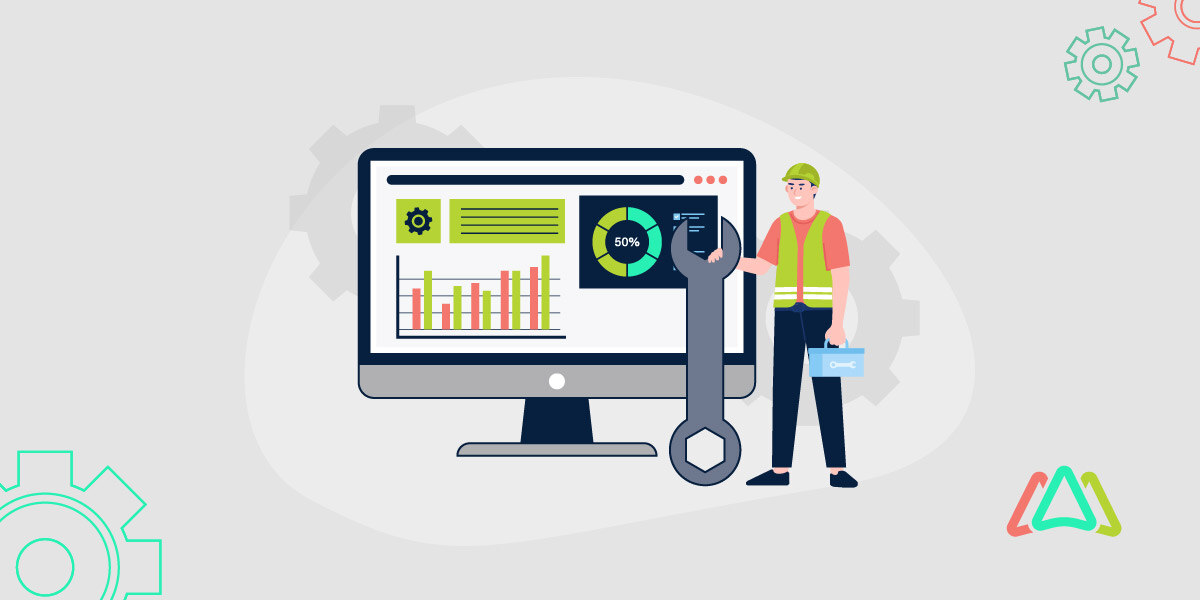
Maintenance as a Service: Key Benefits and Why Some Businesses Should Consider it
Maintenance as a Service (MaaS) is one of the newer concepts in maintenance management that is designed to drive innovation and efficiency in the industry. MaaS’s rise in popularity rests largely on providing another option in facility maintenance and management. It does this by offering services such as predictive maintenance, inventory management, warranty management, and equipment leasing options.
But this is just the starting point. There’s much more to know about MaaS and how it is reshaping the landscape of facility and maintenance management and driving new levels of productivity and cost-effectiveness.
Understanding MaaS:
To fully appreciate what MaaS has to offer and how companies can benefit from it.
Unlike conventional maintenance models, MaaS is a subscription-based model allowing businesses to outsource the responsibility of maintaining their assets to a third-party provider. This means that the third-party provider takes on comprehensive responsibility for managing a company’s maintenance needs for anything from routine upkeep to handling more complex repairs and system upgrades.
The goals of using MaaS are to streamline asset management and shift the responsibility of maintenance operations away from companies. What this means is with MaaS, companies no longer need to bear the burden of staffing, scheduling, or overseeing maintenance tasks. By being relieved of this responsibility, companies can instead focus on their core activities while the third-party provider ensures that all maintenance requirements are met efficiently and reliably.
Key Features and Attributes of MaaS:
Scalability
Scalability is a feature that differentiates MaaS from conventional maintenance options. Traditional maintenance often involves fixed contracts and labor-intensive processes that can be cumbersome to scale. MaaS, however, makes it possible to adjust their service levels based on changing needs without the constraints of long-term investment and financial commitments to upgrading maintenance processes. Organizations can easily scale their maintenance services up or down, ensuring they only pay for what they use and not what they are committed to.
Flexibility
MaaS is best recognized for its flexibility. This means that businesses can tailor their maintenance services to suit their specific requirements. Specifically, they can choose from various service models, including predictive maintenance as a service and inventory management as a service. This adaptability enables organizations to implement maintenance strategies that align closely with their operational goals, improving responsiveness to market demands.
Access to Advanced Technologies
MaaS offers companies access to advanced technologies—such as IoT devices, smart sensors, and AI-driven analytics. These same advanced technologies may be cost-prohibitive under traditional maintenance frameworks. This is especially true for smaller businesses that may otherwise miss out on these sophisticated tools to enhance their operations.
By understanding these differences, it’s now possible to appreciate the transformative potential of MaaS in facility management.

The Role of MaaS in Facility Management:
MaaS features such as Internet of Things (IoT) devices and smart sensors that monitor facility systems in real-time offer immediate insights into equipment health, energy usage, and environmental conditions, enabling managers to make informed decisions on the spot.
By integrating inventory management as a service, organizations can ensure that all necessary parts and supplies are readily available when needed. This eliminates unnecessary parts shortages and the associated time lags until they are received.
Integrating predictive maintenance as a service enables facility managers to anticipate equipment failures, ensuring timely interventions and extending the lifespan of critical assets.
Benefits of Implementing MaaS in Your Business:
MaaS provides a host of benefits that can significantly enhance operational efficiency.
Predictive Analytics
One of the primary advantages of using predictive analytics is the ability for businesses to forecast potential equipment failures and schedule maintenance proactively. This is made possible by using real-time data from IoT sensors. Among other things, predictive analytics is able to identify equipment performance anomalies by analyzing patterns and trends. For instance, the technology can flag a sudden increase in vibration or temperature in a machine as a sign of a potential failure.
Using a data-driven approach minimizes downtime since maintenance can be performed during off-peak hours rather than during an unanticipated breakdown. In addition, planning maintenance schedules more effectively makes for better resource allocation. Taking such action can ensure that maintenance teams are utilized efficiently and that spare parts are available when needed.
Finally, predictive analytics can provide insights into asset lifespan. This helps organizations make informed decisions about replacements or upgrades. Ultimately, it adds to operational efficiency and contributes to overall cost savings.
Warranty as a Service
Incorporating warranty as a service lets organizations manage their equipment warranties more effectively. Traditional warranty management, with its extensive paperwork, tracking deadlines, and understanding of complex terms and conditions is often less than optimal. With warranty as a service, these limitations are overcome through automated and streamlined processes.
Warranty as a service often includes proactive monitoring of warranty coverage by notifying subscribers of impending expiration dates or potential claims opportunities. With the assistance of IoT data, organizations can provide detailed equipment performance and maintenance history documentation, which is crucial when filing warranty claims. Considered together, they simplify the claims process and increase the likelihood of a claim acceptance.
Finally, warranty as a service can reduce unexpected expenses because companies are more aware of what is covered under warranty and can take timely action to address issues. This form of proactive management fosters stronger relationships with manufacturers and service providers, further enhancing the value offered through warranties.
Equipment Leasing Options
Equipment leasing options enable businesses to access the latest technologies without incurring substantial upfront investments. Given the reality of current economic trends, it’s now more important than ever to remain competitive. Adopting the latest equipment and technology is one way to do so. MaaS makes that possible without incurring the capital expenditures of purchasing new assets.
Equipment leasing often includes maintenance services as part of the package, which can be integrated with MaaS offerings. This means that businesses not only gain access to the latest technology but also benefit from comprehensive maintenance support, enhancing the reliability and performance of their leased assets.
The bottom line is that equipment leasing options position organizations to innovate and adapt quickly by providing the necessary tools to enhance operational efficiency and stay ahead in a competitive landscape. These benefits can be achieved with less financial strain.
Challenges and Solutions in Adopting MaaS:
While the advantages of MaaS are substantial, the transition process often presents unique challenges. Overcoming these challenges requires a strategic plan that addresses technical integration, organizational mindset, and operational security.
Resistance to change
Resistance to change is a primary barrier when introducing MaaS. This is mainly because employees and management are sometimes hesitant to shift away from traditional processes and systems. Concerns over job roles shifting, a lack of familiarity with the technology, and general apprehension about potential disruptions during the transition phase are common reasons for resistance.
Solution
Helping employees overcome resistance is achievable by implementing a phased adoption strategy that starts with smaller, non-critical tasks. This stepwise approach allows employees to build familiarity and confidence with the new system. A comprehensive training program should not only focus on teaching staff how to use the new technologies but also highlight the benefits they bring. Finally, encouraging regular feedback through change management workshops can help create a culture of acceptance.
System Integration Challenges
Integrating existing systems with MaaS platforms can be complicated, particularly when dealing with older systems that may not be compatible with modern MaaS technology. The shift to MaaS typically requires aligning data, workflows, and processes across various systems, which can be labor and time-intensive.
Solution
Overcoming system integration issues is best dealt with by consulting with integration specialists or experienced service providers in inventory management and predictive maintenance. Service providers with expertise in MaaS and predictive maintenance can assist with implementing best practices and integration techniques. Engaging these providers can ensure that the MaaS platform is adapted to the organization’s existing workflows, avoiding disruptions while enabling seamless data flow and accessibility.
Data Security and Compliance
Moving to a cloud-based MaaS environment opens the door to potential vulnerabilities related to data security and compliance. Sensitive data related to operations, assets, and customer information must be securely managed, especially in industries with strict regulatory standards.
Solution
Investing in robust cybersecurity measures is crucial. Encryption, regular audits, and adherence to industry-specific compliance standards (e.g., GDPR for European businesses and CCPA in California) are central practices for protecting sensitive data. Once again, engaging a MaaS provider that has a track record of strong security protocols and certifications is pivotal in ensuring security and compliance.
Skill Gaps and Training Needs
The technical complexity of MaaS platforms often requires specialized knowledge that is sometimes absent within the organization. Skill gaps in data analytics, predictive maintenance, and cloud computing can slow down the adoption process and hinder the effective utilization of MaaS capabilities.
Solution
As was the case in addressing employee resistance, developing a structured training program or working with a MaaS partner to offer targeted workshops is also valuable. By doing so, skill gaps can be dealt with, and employees can be empowered to use the new tools effectively. By investing in ongoing education in key areas like data analytics, inventory tracking, and predictive algorithms, organizations can also ensure that teams have the skills needed to make data-driven decisions and maximize the value of MaaS.
Cost Management and ROI
Although MaaS can lower operational costs in the long term, the initial investment related to system upgrades, staff training, and cybersecurity can be substantial. Balancing these initial costs with expected returns on investment (ROI) can be a challenge for businesses.
Solution
Conducting a detailed cost-benefit analysis before adopting a MaaS is essential. This analysis should include projections for both short-term and long-term ROI. It should also consider factors like reduced downtime from predictive maintenance and lower inventory costs through better management practices.
While researching MaaS providers, keep in mind that some offer flexible pricing models, such as pay-as-you-go or subscription-based options. These options allow businesses to align costs more closely with usage. Taking advantage of such options can help organizations avoid high upfront investment and realize immediate value as they gradually scale their use of MaaS.
Future Trends in MaaS for Facility Management
The future of MaaS in facility management is positioned for significant growth by keeping pace with advancements in technology and evolving business needs. With the expansion of machine learning and AI, enhanced predictive maintenance and inventory management capabilities will follow suit.
Additionally, the rise of warranty as a service will enable organizations to optimize asset utilization, ensuring that equipment is always maintained under optimal conditions. It is expected that the adoption of equipment leasing options will also expand, giving businesses more flexibility and access to cutting-edge technology without the burden of ownership.
Conclusion
MaaS is gaining traction as a recognizable force in facility management. By implementing technologies such as IoT, predictive analytics, and various service models like inventory management, predictive maintenance, and warranty, organizations are now able to enhance operational efficiency and reduce costs. Equipment leasing options make it possible for businesses to adapt to changing demands while optimizing resource allocation without incurring large upfront costs.
As organizations continue to grow, transform, and adapt, MaaS will likely play a critical role in supporting innovation and sustainable practices moving forward.
TABLE OF CONTENTS
Keep Reading
Ever find yourself checking into a luxury hotel and expecting a relaxing stay, only to find a ...
11 Apr 2025
Organizations are witnessing swift changes in the business environment and confronting a ...
8 Apr 2025
Last month, news outlets and the entire internet was abuzz with the return of NASA astronauts ...
3 Apr 2025
What comes first - CMMS or predictive maintenance? If your answer is either, it is correct. ...
28 Mar 2025
Artificial intelligence (AI) talk has become commonplace. Today, engaging in business-focused ...
27 Mar 2025
Imagine a world where machines predict, diagnose, and fix their issues before they fail. This ...
25 Mar 2025
A facility maintenance plan is at the core of a facility’s operations. This organized ...
21 Mar 2025
Think of managing your maintenance operations like managing a championship sports team. Just ...
21 Mar 2025
The maintenance sector is battling a severe talent shortage that threatens to undermine ...
7 Mar 2025
Manufacturing maintenance is the backbone of industrial efficiency, ensuring machines run ...
5 Mar 2025
No one likes playing a guessing game when equipment breaks down. Yet, maintenance teams often ...
4 Mar 2025
The size of the preventive maintenance software market is discussed in millions of dollars, ...
4 Mar 2025
The organizational structure and corporate hierarchy vary from company to company. Large ...
28 Feb 2025
Maintenance procedures are essential for ensuring the longevity and reliability of machinery ...
21 Feb 2025
Sustainability is no longer just a buzzword; it's a critical component of corporate social ...
20 Feb 2025
A Computerized Maintenance Management System (CMMS) relies on accurate, well-organized data ...
18 Feb 2025
In an era where technology drives operational efficiency, Computerized Maintenance Management ...
14 Feb 2025
A Computerized Maintenance Management System (CMMS) is a key component of modern maintenance ...
13 Feb 2025
Introduction Maintenance management is the foundation of maintenance operations in industries ...
11 Feb 2025
Introduction A Computerized Maintenance Management System (CMMS) is software designed to help ...
7 Feb 2025






